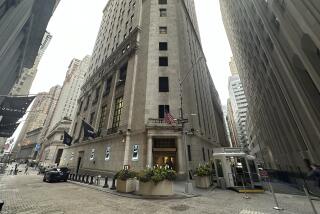CURRENCY : Intervention Puts Brakes on the Dollar
- Share via
NEW YORK — The buoyant U.S. dollar ended mixed after a nervous session Friday, as joint central bank intervention offset the currency’s initial rise on a strong U.S. employment report for last month.
After a strong surge that followed the release of the economic reports, the dollar ended narrowly higher against the West German mark and British pound but lower against the Japanese yen and Canadian dollar.
Gold prices, after dipping as low as $387 an ounce, ended up slightly higher. Republic National Bank of New York said gold bullion was bid at $391.50 as of 4 p.m. EST, up from $391.10 late Thursday.
January non-farm payroll employment rose by 408,000, compared to forecasts of 291,000 new jobs, the government reported in the morning. The data, indicating that the U.S. economy is still booming, rekindled fears that the Federal Reserve will soon nudge interest rates higher.
The strong job growth overshadowed the announcement that the unemployment rate rose 0.1 percentage point to 5.4% in January.
Also, the Commerce Department said factory orders shot up 4.1% in December, the biggest monthly gain since June.
The twin reports indicated to investors that the Federal Reserve would have to keep short-term interest rates high to prevent the economy from overheating. “There’s still very strong short-term rates here, and that’s what’s bringing money into the country,” said Dan Brooks, chief dealer of Westpac Banking Corp. in New York.
Traders in Europe and the United States said the dollar’s upward move was countered by coordinated dollar sales by the central banks of the United States, West Germany, the Netherlands, France, Italy, Belgium, Switzerland and Austria.
In Tokyo, where trading ended before the release of the U.S. economic reports, the dollar fell 0.48 yen to a closing 129.27 yen. Later, in London, it was quoted at 129.40 yen. In New York, the dollar dipped to 129.40 from 129.58 late Thursday.
In London, the dollar rose against the pound, which cost $1.7410, cheaper than $1.7515 on Thursday. In New York, the dollar also strengthened. The pound fell to $1.7420 from $1.7452 on Thursday.
Other late dollar rates in New York, compared to late Thursday’s rates, included: 1.8790 West German marks, up from 1.8775; 1.5949 Swiss francs, up from 1.5945; 1.1833 Canadian dollars, down from 1.1894; 6.3880 French francs, unchanged, and 1,371.8 Italian lire, up from 1,371.3.
Other late dollar rates in Europe, compared to late Thursday’s rates, included: 1.8805 West German marks, up from 1.8700; 1.5983 Swiss francs, up from 1.5923; 6.3950 French francs, up from 6.3735; 2.1240 Dutch guilders, up from 2.1135; 1,374.50 Italian lire, up from 1,368.50, and 1.1885 Canadian dollars, up from 1.1882.
Gold prices were lower in Europe but rose by the end of trading in New York.
In London, gold traded at a late bid of $388.25 an ounce, down from $392.25 late Thursday. In Zurich, Switzerland, gold fell to $389.90 from $391.50.
On the Commodity Exchange in New York, gold bullion for current delivery closed at $393.10, up from $392.30.
Silver was quoted in London on at $5.83 an ounce, down from Thursday’s $5.86. On New York’s Comex, silver bullion for current delivery rose to $5.835 from $5.823.
Tables, Page 10
More to Read
Sign up for Essential California
The most important California stories and recommendations in your inbox every morning.
You may occasionally receive promotional content from the Los Angeles Times.













